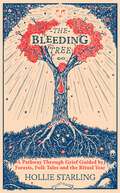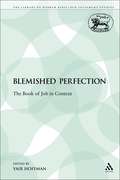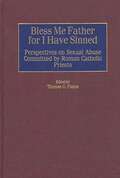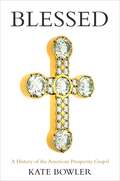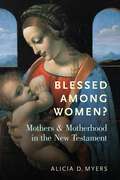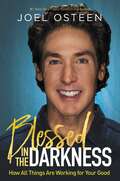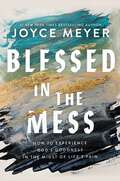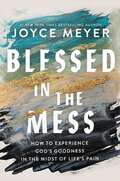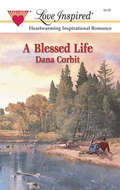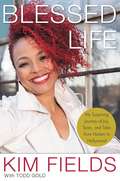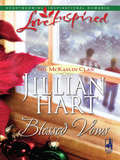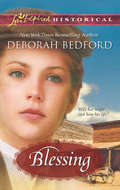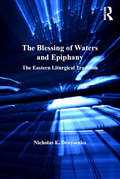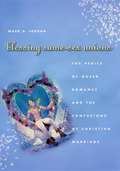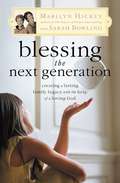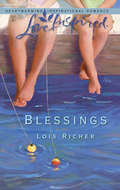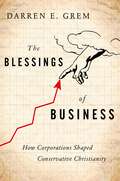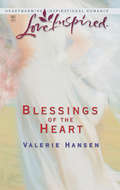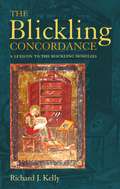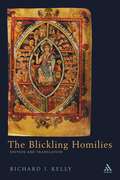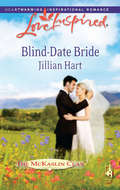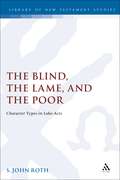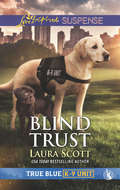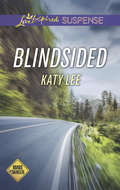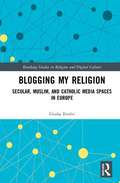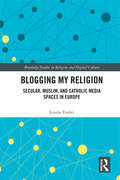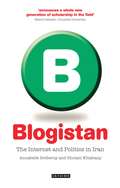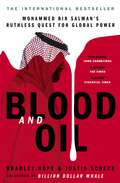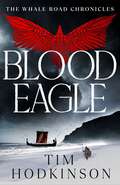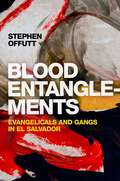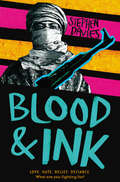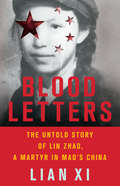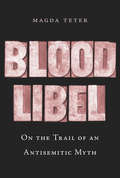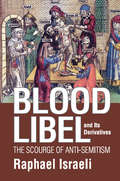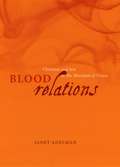The Bleeding Tree: A Pathway Through Grief Guided by Forests, Folk Tales and the Ritual Year
by Hollie StarlingIt was the last of the ebbing days, the brink of the new season. It was the murky hours, the clove between sunset and sunrise. It was a tall tree with deep roots and it had been bleeding for a long while.As summer falls into autumn, Hollie Starling is hit by the heart-stopping news that her father has died by suicide. Thrust into a state of 'grief on hard mode', Hollie feels underserved by current attitudes toward grief and so seeks another way through the dark.Following her first year without her father, Hollie embraces her lifelong interest in folklore and turns to the healing power of nature, the changing seasons and the rituals of ancient communities. The Bleeding Tree is an unflinching year-zero guidebook to grief that shows us that by looking back to past traditions of bereavement we can all find our own way forward.
A Blemished Perfection: The Book of Job in Context (The Library of Hebrew Bible/Old Testament Studies)
by Yair HoffmanThe main methodological thesis of this study is that the book of Job, more than any other book in the Bible, should be treated as an artistic work in which form and content cannot be separated. Hence, a good acquaintance with the literary aspects of the book, including its relations with other ancient Near Eastern texts, is a precondition to the understanding of its theology. The deep structure of the book is that of a catalogue-which is a key to understanding its approach to the problem of theodicy. The difficult language of Job is scrutinized, and is proved to be an original and immanent characteristic of the book. A synthesis of the literary, linguistic and theological characteristics of Job leads to its paradoxical-not absurd-definition as 'a blemished perfection'.
Bless Me Father for I Have Sinned: Perspectives on Sexual Abuse Committed by Roman Catholic Priests (Non-ser.)
by Thomas G. Ph.D.A tremendous amount of media attention has been devoted to revealing sexual abuse perpetrated by Roman Catholic priests. These essays outline a clinical and research agenda for professionals dealing with clergy sexual abuse. They should enable research clinical professionals, and clergy to identify the relevant issues in the identification, diagnosis, treatment, and prevention of child and adolescent sexual abuse committed by Roman Catholic priests. Leading experts in the field from the United States and Canada have offered their different perspectives on this compelling problem including victim profiles for determining who is at risk.
Blessed: A History of the American Prosperity Gospel
by Kate BowlerHow have millions of American Christians come to measure spiritual progress in terms of their financial status and physical well-being? How has the movement variously called Word of Faith, Health and Wealth, Name It and Claim It, or simply prosperity gospel come to dominate much of our contemporary religious landscape? Kate Bowler's Blessed is the first book to fully explore the origins, unifying themes, and major figures of a burgeoning movement that now claims millions of followers in America. Bowler traces the roots of the prosperity gospel: from the touring mesmerists, metaphysical sages, pentecostal healers, business oracles, and princely prophets of the early 20th century; through mid-century positive thinkers like Norman Vincent Peale and revivalists like Oral Roberts and Kenneth Hagin; to today's hugely successful prosperity preachers. Bowler focuses on such contemporary figures as Creflo Dollar, pastor of Atlanta's 30,000-member World Changers Church International; Joel Osteen, known as "the smiling preacher," with a weekly audience of seven million; T. D. Jakes, named by Time magazine one of America's most influential new religious leaders; Joyce Meyer, evangelist and women's empowerment guru; and many others. At almost any moment, day or night, the American public can tune in to these preachers-on TV, radio, podcasts, and in their megachurches-to hear the message that God desires to bless them with wealth and health. Bowler offers an interpretive framework for scholars and general readers alike to understand the diverse expressions of Christian abundance as a cohesive movement bound by shared understandings and common goals.
Blessed: A History of the American Prosperity Gospel
by Kate BowlerHow have millions of American Christians come to measure spiritual progress in terms of their financial status and physical well-being? How has the movement variously called Word of Faith, Health and Wealth, Name It and Claim It, or simply prosperity gospel come to dominate much of our contemporary religious landscape? Kate Bowler's Blessed is the first book to fully explore the origins, unifying themes, and major figures of a burgeoning movement that now claims millions of followers in America. Bowler traces the roots of the prosperity gospel: from the touring mesmerists, metaphysical sages, pentecostal healers, business oracles, and princely prophets of the early 20th century; through mid-century positive thinkers like Norman Vincent Peale and revivalists like Oral Roberts and Kenneth Hagin; to today's hugely successful prosperity preachers. Bowler focuses on such contemporary figures as Creflo Dollar, pastor of Atlanta's 30,000-member World Changers Church International; Joel Osteen, known as "the smiling preacher," with a weekly audience of seven million; T. D. Jakes, named by Time magazine one of America's most influential new religious leaders; Joyce Meyer, evangelist and women's empowerment guru; and many others. At almost any moment, day or night, the American public can tune in to these preachers-on TV, radio, podcasts, and in their megachurches-to hear the message that God desires to bless them with wealth and health. Bowler offers an interpretive framework for scholars and general readers alike to understand the diverse expressions of Christian abundance as a cohesive movement bound by shared understandings and common goals.
Blessed Among Women?: Mothers and Motherhood in the New Testament
by Alicia D. MyersMothers appear throughout the New Testament. Called "blessed among women" by Elizabeth in the Gospel of Luke, Mary, the mother of Jesus, is the most obvious example. But she is far from the only mother in this canon. She is joined by Elizabeth, a chorus of unnamed mothers seeking healing or promotions for their children, as well as male mothers, including Paul (Gal 4:19-20) and Jesus. Although interpreters of the New Testament have explored these maternal characters and metaphors, many have only recently begun to take seriously their theological aspects. This book builds on previous studies by arguing maternal language is not only theological, but also indebted to ancient gender constructions and their reshaping by early Christians. Especially significant are the physiological, anatomical, and social constructions of female bodies that permeate the ancient world where ancient Christianity was birthed. This book examines ancient generative theories, physiological understandings of breast milk and breastfeeding, and presentations of prominent mothers in literature and art to analyze the use of these themes in the New Testament and several, additional early Christian writings. In a context that aligned perfection with "masculinity," motherhood was the ideal goal for women-a justification for deficient, female existence. Proclaiming a new age ushered in by God's Christ, however, ancient Christians debated the place of women, mothers, and motherhood as a part of their reframing of gender expectations. Rather than a homogenous approval of literal motherhood, ancient Christian writings depict a spectrum of ideals for women disciples even as they retain the assumption of masculine superiority. Identifying themselves as members of God's household, ancient Christians utilized motherhood as a theological category and a contested ideal for women disciples.
Blessed Among Women?: Mothers and Motherhood in the New Testament
by Alicia D. MyersMothers appear throughout the New Testament. Called "blessed among women" by Elizabeth in the Gospel of Luke, Mary, the mother of Jesus, is the most obvious example. But she is far from the only mother in this canon. She is joined by Elizabeth, a chorus of unnamed mothers seeking healing or promotions for their children, as well as male mothers, including Paul (Gal 4:19-20) and Jesus. Although interpreters of the New Testament have explored these maternal characters and metaphors, many have only recently begun to take seriously their theological aspects. This book builds on previous studies by arguing maternal language is not only theological, but also indebted to ancient gender constructions and their reshaping by early Christians. Especially significant are the physiological, anatomical, and social constructions of female bodies that permeate the ancient world where ancient Christianity was birthed. This book examines ancient generative theories, physiological understandings of breast milk and breastfeeding, and presentations of prominent mothers in literature and art to analyze the use of these themes in the New Testament and several, additional early Christian writings. In a context that aligned perfection with "masculinity," motherhood was the ideal goal for women-a justification for deficient, female existence. Proclaiming a new age ushered in by God's Christ, however, ancient Christians debated the place of women, mothers, and motherhood as a part of their reframing of gender expectations. Rather than a homogenous approval of literal motherhood, ancient Christian writings depict a spectrum of ideals for women disciples even as they retain the assumption of masculine superiority. Identifying themselves as members of God's household, ancient Christians utilized motherhood as a theological category and a contested ideal for women disciples.
Blessed in the Darkness: How All Things Are Working for Your Good
by Joel OsteenFind comfort in dark times and grow your trust and faith in God with this inspiring and insightful guide from Lakewood Church pastor and #1 New York Times bestselling author Joel Osteen. All of us will go through dark times that we don't understand: a difficulty with a friend, an unfair situation at work, a financial setback, an unexpected illness, a divorce, or the loss of a loved one. Those types of experiences are part of the human journey. But when we find ourselves in such a place, it's important that we keep a positive perspective. Joel Osteen writes that if we stay in faith and keep a good attitude when we go through challenges, we will not only grow, but we will see how all things work together for our good. Through practical applications and scriptural insight, Blessed in the Darkness focuses on how to draw closer to God and trust Him when life doesn't make sense.If we will go through the dark place in the valley trusting, believing, and knowing that God is still in control, we will come to the table that is already prepared for us, where our cup runs over.
Blessed in the Darkness: How All Things Are Working for Your Good
by Joel OsteenFind comfort in dark times and grow your trust and faith in God with this inspiring and insightful guide from Lakewood Church pastor and #1 New York Times bestselling author Joel Osteen. All of us will go through dark times that we don't understand: a difficulty with a friend, an unfair situation at work, a financial setback, an unexpected illness, a divorce, or the loss of a loved one. Those types of experiences are part of the human journey. But when we find ourselves in such a place, it's important that we keep a positive perspective. Joel Osteen writes that if we stay in faith and keep a good attitude when we go through challenges, we will not only grow, but we will see how all things work together for our good. Through practical applications and scriptural insight, Blessed in the Darkness focuses on how to draw closer to God and trust Him when life doesn't make sense.If we will go through the dark place in the valley trusting, believing, and knowing that God is still in control, we will come to the table that is already prepared for us, where our cup runs over.
Blessed in the Mess: How to Experience God’s Goodness in the Midst of Life’s Pain
by Joyce MeyerCan we truly find peace and even blessing amid the chaos, the disappointments, and the messes that life brings our way?Life is often messy. We hear people say, 'My life is a mess', or, 'This situation is a mess'. What they mean is that life has become difficult and confusing. God never promises us a trouble-free life. In fact, His Word tells us to expect the opposite. Jesus says, 'In the world you will have tribulation; but be of good cheer, I have overcome the world' (John 16:33 NKJV).Thankfully, trouble is not continuous in our lives. We also go through seasons that are peaceful and pleasant. But life does not always go as we would like, and we need to be prepared for the times when it gets messy.In Blessed in the Mess, beloved Bible teacher Joyce Meyer shows us how to be blessed even amid life's most challenging circumstances. The Bible is filled with instructions on how to handle ourselves when difficulty comes our way, and Blessed in the Mess collects that wisdom into poignant and practical teaching that equips us to remain stable and hopeful in every situation. No matter what unpleasant circumstances we may face, we can remain joyful and patient, trusting God as He works on our problems. If you have not handled your problems well in the past, then with God's help, you can begin to handle them better, starting now.It is possible to allow our difficulties to make us better and to live in such a way that we will end up better off than we were before the trouble began. We should never waste our pain. Through the wisdom distilled in this book, we can learn how to gain something from our messes, use what we've learned to stay out of trouble in the future, and allow our newfound wisdom to help other people mind blessing in the mist of their messes.
Blessed in the Mess: How to Experience God's Goodness in the Midst of Life's Pain
by Joyce MeyerRenowned Bible teacher and #1 New York Times bestselling author Joyce Meyer shows readers how to not just survive but thrive amidst both the everyday and the monumental messes we experience in life. Life is often messy. We hear people say, &“My life is a mess,&” or &“This situation is a mess.&” What they mean is that life has become difficult, painful or confusing. But God never promised us a trouble-free life. In fact, His Word tells us to expect the opposite. In John 16:33, Jesus says, &“In this world you will have trouble. But take heart! I have overcome the world&” (NIV). In Blessed in the Mess, beloved Bible teacher Joyce Meyer shows us how to be blessed in the midst of life&’s most challenging circumstances. The Bible is filled with instructions on how to handle ourselves when difficulty comes our way, and Blessed in the Mess shares that wisdom through poignant and practical teaching that equips us to remain stable and hopeful in every situation. No matter what problems we may face, there is a way to remain joyful and patient as God works on them. If you have not handled the messy issues or challenges in your life well in the past, then with God's help, you can begin to manage them better, starting now. We should never waste our pain. Through the wisdom distilled in this book, we can learn how to gain something from our messes, use those insights to avoid trouble in the future, and share our experiences to help other people find blessings in the midst of their messes. A study guide as well as a Spanish edition, Bendición en el desorden, are also available for purchase.
A Blessed Life (Mills And Boon Love Inspired Ser.)
by Dana CorbitTHERE ARE ANGELS AMONG US AND SOME RIDE MOTORCYCLES
Blessed Life: My Surprising Journey of Joy, Tears, and Tales from Harlem to Hollywood
by Kim FieldsFrom "Facts of Life" to "Living Single" to "Dancing with the Stars" to wife and mom, here's the BLESSED LIFE of Kim Fields, veteran actress, TV personality, and star. Kim Fields has lived most of her life with people thinking they know her, which is understandable. From her first job on a Mrs. Butterworth syrup commercial at age 7, she has spent 40 years in the public eye. There were 9 years as Dorothy "Tootie" Ramsey on the classic sitcom The Facts of Life, 5 more in her 20s starring as Regine Hunter on the seminal coming-of-age show Living Single, and most recently appearing as herself on Real Housewives of Atlanta and Dancing with the Stars. Behind the camera, she has directed episodes of Kenan & Kel, Tyler Perry's Meet the Browns and House of Payne, and BET's Let's Stay Together. Between gigs, the pop culture icon's life has included theater, spoken word, music, speaking engagements, and simply being present to the point that she cannot go a day without someone stopping her to say, "When I was a kid, I wanted to be Tootie" or "You were my role model." Flattered and blessed, after four decades in the business, Kim finally understands the role she has played onscreen and off as a successful, outspoken African-American woman. However, for as much as she's been in the public eye, people have really never known her the way they think they have, and that's because she, herself, spent most of her life figuring herself out. Now, at age 48, she is ready to set the record straight. She says, "It's not that I've been misunderstood. It's that I finally feel like I understand me enough to tell the life story that I've been asked to write for years." It will be a chronicle of living, learning, and keen moments of self-discovery as she's journeyed through the many facets and chapters of life. Fields found faith at age 14 and has found God to be right there every step of the way since then.
Blessed Life: My Surprising Journey of Joy, Tears, and Tales from Harlem to Hollywood
by Kim FieldsFrom "Facts of Life" to "Living Single" to "Dancing with the Stars" to wife and mom, here's the Blessed Life of Kim Fields, veteran actress, TV personality, and star. Kim Fields has lived most of her life with people thinking they know her, which is understandable. From her first job on a Mrs. Butterworth syrup commercial at age 7, she has spent 40 years in the public eye. There were 9 years as Dorothy "Tootie" Ramsey on the classic sitcom The Facts of Life, 5 more in her 20s starring as Regine Hunter on the seminal coming-of-age show Living Single, and most recently appearing as herself on Real Housewives of Atlanta and Dancing with the Stars. Behind the camera, she has directed episodes of Kenan & Kel, Tyler Perry's Meet the Browns and House of Payne, and BET's Let's Stay Together. Between gigs, the pop culture icon's life has included theater, spoken word, music, speaking engagements, and simply being present to the point that she cannot go a day without someone stopping her to say, "When I was a kid, I wanted to be Tootie" or "You were my role model." Flattered and blessed, after four decades in the business, Kim finally understands the role she has played onscreen and off as a successful, outspoken African-American woman. However, for as much as she's been in the public eye, people have really never known her the way they think they have, and that's because she, herself, spent most of her life figuring herself out. Now, at age 48, she is ready to set the record straight. She says, "It's not that I've been misunderstood. It's that I finally feel like I understand me enough to tell the life story that I've been asked to write for years." It will be a chronicle of living, learning, and keen moments of self-discovery as she's journeyed through the many facets and chapters of life. Fields found faith at age 14 and has found God to be right there every step of the way since then.
Blessed Vows: Sweet Blessings Blessed Vows (Mills And Boon Love Inspired Ser.)
by Jillian HartWhen waitress Rachel McKaslin reluctantly let Jake McCall move into the apartment above her family's diner, she never dreamed the handsome tech sergeant would be so charming. Soon into their joyful courtship, Jake surprised her by proposing. Now, Rachel prayed their union wasn't just a convenience and that Jake truly loved her.
Blessing (Mills And Boon Love Inspired Historical Ser.)
by Deborah BedfordLADY IN DISGUISE Though the secret behind Uley Kirland’s cap and mining togs is unsuspected in 1880s Tin Cup, Colorado, she longs to shed the clothing of deception…especially when handsome stranger Aaron Brown awakens her woman’s heart.
The Blessing of Waters and Epiphany: The Eastern Liturgical Tradition (Liturgy, Worship and Society Series)
by Nicholas E. DenysenkoThis book examines the historical development of the blessing of waters and its theology in the East, with an emphasis on the Byzantine tradition. Exploring how Eastern Christians have sought these waters as a source of healing, purification, and communion with God, Denysenko unpacks their euchology and ritual context. The history and theology of the blessing of waters on Epiphany is informative for contemporary theologians, historians, pastors and students. Offering important insights into how Christians renew Baptism in receiving the blessed waters, this book also proposes new perspectives for theologizing Christian stewardship of ecology in the modern era based on a patristic liturgical synthesis. Denysenko presents an alternative framework for understanding the activity of the Trinity, enabling readers to encounter a vision of how participants encounter God in and after ritual.
The Blessing of Waters and Epiphany: The Eastern Liturgical Tradition (Liturgy, Worship and Society Series)
by Nicholas E. DenysenkoThis book examines the historical development of the blessing of waters and its theology in the East, with an emphasis on the Byzantine tradition. Exploring how Eastern Christians have sought these waters as a source of healing, purification, and communion with God, Denysenko unpacks their euchology and ritual context. The history and theology of the blessing of waters on Epiphany is informative for contemporary theologians, historians, pastors and students. Offering important insights into how Christians renew Baptism in receiving the blessed waters, this book also proposes new perspectives for theologizing Christian stewardship of ecology in the modern era based on a patristic liturgical synthesis. Denysenko presents an alternative framework for understanding the activity of the Trinity, enabling readers to encounter a vision of how participants encounter God in and after ritual.
Blessing Same-Sex Unions: The Perils of Queer Romance and the Confusions of Christian Marriage
by Mark D. JordanAt most church weddings, the person presiding over the ritual is not a priest or a pastor, but the wedding planner, followed by the photographer, the florist, and the caterer. And in this day and age, more wedding theology is supplied by Modern Bride magazine or reality television than by any of the Christian treatises on holy matrimony. Indeed, church weddings have strayed long and far from distinctly Christian aspirations. The costumes and gestures might still be right, but the intentions are hardly religious. Why then, asks noted gay commentator Mark D. Jordan, are so many churches vehemently opposed to blessing same-sex unions? In this incisive work, Jordan shows how carefully selected ideals of Christian marriage have come to dominate recent debates over same-sex unions. Opponents of gay marriage, he reveals, too often confuse simplified ideals of matrimony with historical facts. They suppose, for instance, that there has been a stable Christian tradition of marriage across millennia, when in reality Christians have quarreled among themselves for centuries about even the most basic elements of marital theology, authorizing experiments like polygamy and divorce. Jordan also argues that no matter what the courts do, Christian churches will have to decide for themselves whether to bless same-sex unions. No civil compromise can settle the religious questions surrounding gay marriage. And queer Christians, he contends, will have to discover for themselves what they really want out of marriage. If they are not just after legal recognition as a couple or a place at the social table, do they really seek the blessing of God? Or just the garish melodrama of a white wedding? Posing trenchant questions such as these, Blessing Same-Sex Unions will be a must-read for both sides of the debate over gay marriage in America today.
Blessing Same-Sex Unions: The Perils of Queer Romance and the Confusions of Christian Marriage
by Mark D. JordanAt most church weddings, the person presiding over the ritual is not a priest or a pastor, but the wedding planner, followed by the photographer, the florist, and the caterer. And in this day and age, more wedding theology is supplied by Modern Bride magazine or reality television than by any of the Christian treatises on holy matrimony. Indeed, church weddings have strayed long and far from distinctly Christian aspirations. The costumes and gestures might still be right, but the intentions are hardly religious. Why then, asks noted gay commentator Mark D. Jordan, are so many churches vehemently opposed to blessing same-sex unions? In this incisive work, Jordan shows how carefully selected ideals of Christian marriage have come to dominate recent debates over same-sex unions. Opponents of gay marriage, he reveals, too often confuse simplified ideals of matrimony with historical facts. They suppose, for instance, that there has been a stable Christian tradition of marriage across millennia, when in reality Christians have quarreled among themselves for centuries about even the most basic elements of marital theology, authorizing experiments like polygamy and divorce. Jordan also argues that no matter what the courts do, Christian churches will have to decide for themselves whether to bless same-sex unions. No civil compromise can settle the religious questions surrounding gay marriage. And queer Christians, he contends, will have to discover for themselves what they really want out of marriage. If they are not just after legal recognition as a couple or a place at the social table, do they really seek the blessing of God? Or just the garish melodrama of a white wedding? Posing trenchant questions such as these, Blessing Same-Sex Unions will be a must-read for both sides of the debate over gay marriage in America today.
Blessing Same-Sex Unions: The Perils of Queer Romance and the Confusions of Christian Marriage
by Mark D. JordanAt most church weddings, the person presiding over the ritual is not a priest or a pastor, but the wedding planner, followed by the photographer, the florist, and the caterer. And in this day and age, more wedding theology is supplied by Modern Bride magazine or reality television than by any of the Christian treatises on holy matrimony. Indeed, church weddings have strayed long and far from distinctly Christian aspirations. The costumes and gestures might still be right, but the intentions are hardly religious. Why then, asks noted gay commentator Mark D. Jordan, are so many churches vehemently opposed to blessing same-sex unions? In this incisive work, Jordan shows how carefully selected ideals of Christian marriage have come to dominate recent debates over same-sex unions. Opponents of gay marriage, he reveals, too often confuse simplified ideals of matrimony with historical facts. They suppose, for instance, that there has been a stable Christian tradition of marriage across millennia, when in reality Christians have quarreled among themselves for centuries about even the most basic elements of marital theology, authorizing experiments like polygamy and divorce. Jordan also argues that no matter what the courts do, Christian churches will have to decide for themselves whether to bless same-sex unions. No civil compromise can settle the religious questions surrounding gay marriage. And queer Christians, he contends, will have to discover for themselves what they really want out of marriage. If they are not just after legal recognition as a couple or a place at the social table, do they really seek the blessing of God? Or just the garish melodrama of a white wedding? Posing trenchant questions such as these, Blessing Same-Sex Unions will be a must-read for both sides of the debate over gay marriage in America today.
Blessing Same-Sex Unions: The Perils of Queer Romance and the Confusions of Christian Marriage
by Mark D. JordanAt most church weddings, the person presiding over the ritual is not a priest or a pastor, but the wedding planner, followed by the photographer, the florist, and the caterer. And in this day and age, more wedding theology is supplied by Modern Bride magazine or reality television than by any of the Christian treatises on holy matrimony. Indeed, church weddings have strayed long and far from distinctly Christian aspirations. The costumes and gestures might still be right, but the intentions are hardly religious. Why then, asks noted gay commentator Mark D. Jordan, are so many churches vehemently opposed to blessing same-sex unions? In this incisive work, Jordan shows how carefully selected ideals of Christian marriage have come to dominate recent debates over same-sex unions. Opponents of gay marriage, he reveals, too often confuse simplified ideals of matrimony with historical facts. They suppose, for instance, that there has been a stable Christian tradition of marriage across millennia, when in reality Christians have quarreled among themselves for centuries about even the most basic elements of marital theology, authorizing experiments like polygamy and divorce. Jordan also argues that no matter what the courts do, Christian churches will have to decide for themselves whether to bless same-sex unions. No civil compromise can settle the religious questions surrounding gay marriage. And queer Christians, he contends, will have to discover for themselves what they really want out of marriage. If they are not just after legal recognition as a couple or a place at the social table, do they really seek the blessing of God? Or just the garish melodrama of a white wedding? Posing trenchant questions such as these, Blessing Same-Sex Unions will be a must-read for both sides of the debate over gay marriage in America today.
Blessing Same-Sex Unions: The Perils of Queer Romance and the Confusions of Christian Marriage
by Mark D. JordanAt most church weddings, the person presiding over the ritual is not a priest or a pastor, but the wedding planner, followed by the photographer, the florist, and the caterer. And in this day and age, more wedding theology is supplied by Modern Bride magazine or reality television than by any of the Christian treatises on holy matrimony. Indeed, church weddings have strayed long and far from distinctly Christian aspirations. The costumes and gestures might still be right, but the intentions are hardly religious. Why then, asks noted gay commentator Mark D. Jordan, are so many churches vehemently opposed to blessing same-sex unions? In this incisive work, Jordan shows how carefully selected ideals of Christian marriage have come to dominate recent debates over same-sex unions. Opponents of gay marriage, he reveals, too often confuse simplified ideals of matrimony with historical facts. They suppose, for instance, that there has been a stable Christian tradition of marriage across millennia, when in reality Christians have quarreled among themselves for centuries about even the most basic elements of marital theology, authorizing experiments like polygamy and divorce. Jordan also argues that no matter what the courts do, Christian churches will have to decide for themselves whether to bless same-sex unions. No civil compromise can settle the religious questions surrounding gay marriage. And queer Christians, he contends, will have to discover for themselves what they really want out of marriage. If they are not just after legal recognition as a couple or a place at the social table, do they really seek the blessing of God? Or just the garish melodrama of a white wedding? Posing trenchant questions such as these, Blessing Same-Sex Unions will be a must-read for both sides of the debate over gay marriage in America today.
Blessing Same-Sex Unions: The Perils of Queer Romance and the Confusions of Christian Marriage
by Mark D. JordanAt most church weddings, the person presiding over the ritual is not a priest or a pastor, but the wedding planner, followed by the photographer, the florist, and the caterer. And in this day and age, more wedding theology is supplied by Modern Bride magazine or reality television than by any of the Christian treatises on holy matrimony. Indeed, church weddings have strayed long and far from distinctly Christian aspirations. The costumes and gestures might still be right, but the intentions are hardly religious. Why then, asks noted gay commentator Mark D. Jordan, are so many churches vehemently opposed to blessing same-sex unions? In this incisive work, Jordan shows how carefully selected ideals of Christian marriage have come to dominate recent debates over same-sex unions. Opponents of gay marriage, he reveals, too often confuse simplified ideals of matrimony with historical facts. They suppose, for instance, that there has been a stable Christian tradition of marriage across millennia, when in reality Christians have quarreled among themselves for centuries about even the most basic elements of marital theology, authorizing experiments like polygamy and divorce. Jordan also argues that no matter what the courts do, Christian churches will have to decide for themselves whether to bless same-sex unions. No civil compromise can settle the religious questions surrounding gay marriage. And queer Christians, he contends, will have to discover for themselves what they really want out of marriage. If they are not just after legal recognition as a couple or a place at the social table, do they really seek the blessing of God? Or just the garish melodrama of a white wedding? Posing trenchant questions such as these, Blessing Same-Sex Unions will be a must-read for both sides of the debate over gay marriage in America today.
Blessing the Next Generation: Creating a Lasting Family Legacy with the Help of a Loving God
by Marilyn Hickey Sarah BowlingThe mother and daughter team of Marilyn Hickey and Sarah Bowling explain the significance of generational curses and blessings and how readers have the power to have an impact on the spiritual heritage they hand to their children.
Blessings (Blessings in Disguise #1)
by Lois RicherA thriving medical practice and three rambunctious daughters have Joshua Darling looking heavenward for help. The harried widower' s prayers are answered when a young surgeon accepts a temporary position in his small-town practice.
The Blessings of Business: How Corporations Shaped Conservative Christianity
by Darren E. GremThe Book of Matthew cautions readers that "Ye cannot serve God and mammon." But for at least a century conservative American Protestants have been trying to prove that adage wrong. In The Blessings of Business, Darren E. Grem argues that while preachers, activists, and politicians have all helped spread the gospel, American evangelicalism owes its enduring strength in a large part to private enterprise. Grem argues for a new history of American evangelicalism, demonstrating how its adherents strategically used corporate America--its leaders, businesses, money, ideas, and values--to advance their religious, cultural, and political movement. Beginning before the First World War, conservative evangelicals were able to use businessmen and business methods to retain and expand their public influence in a secularizing, diversifying, and liberalizing age. In the process they became beholden to pro-business stances on matters of theology, race, gender, taxation, trade, and the state, transforming evangelicalism itself into as much of an economic movement as a religious one. The Blessings of Business tells the story of unlikely partnerships between well-known champions of the evangelical movement such as Billy Graham and largely forgotten businessmen like Herbert Taylor, J. Howard Pew, and R.G. LeTourneau. Grem also shows how evangelicals set up their own pro-business organizations and linked the quarterly and yearly growth of "Christian" businesses to their social, religious, and political aspirations. Fascinating and provocative, The Blessings of Business uncovers the strong ties that conservative Christians have forged between the Almighty and the almighty dollar.
BLESSINGS OF BUSINESS C: How Corporations Shaped Conservative Christianity
by Darren E. GremThe Book of Matthew cautions readers that "Ye cannot serve God and mammon." But for at least a century conservative American Protestants have been trying to prove that adage wrong. In The Blessings of Business, Darren E. Grem argues that while preachers, activists, and politicians have all helped spread the gospel, American evangelicalism owes its enduring strength in a large part to private enterprise. Grem argues for a new history of American evangelicalism, demonstrating how its adherents strategically used corporate America--its leaders, businesses, money, ideas, and values--to advance their religious, cultural, and political movement. Beginning before the First World War, conservative evangelicals were able to use businessmen and business methods to retain and expand their public influence in a secularizing, diversifying, and liberalizing age. In the process they became beholden to pro-business stances on matters of theology, race, gender, taxation, trade, and the state, transforming evangelicalism itself into as much of an economic movement as a religious one. The Blessings of Business tells the story of unlikely partnerships between well-known champions of the evangelical movement such as Billy Graham and largely forgotten businessmen like Herbert Taylor, J. Howard Pew, and R.G. LeTourneau. Grem also shows how evangelicals set up their own pro-business organizations and linked the quarterly and yearly growth of "Christian" businesses to their social, religious, and political aspirations. Fascinating and provocative, The Blessings of Business uncovers the strong ties that conservative Christians have forged between the Almighty and the almighty dollar.
Blessings of The Heart (Mills And Boon Love Inspired Ser. #No. 206)
by Valerie HansenWriter Brianna Walker had moved to the Arkansas hills for a little peace and quiet. But the stormy night a handsome man, two bedraggled boys and a scruffy dog washed up in her front yard, Bree' s peaceful and quiet life became a thing of the past.
The Blickling Concordance: A Lexicon to The Blickling Homilies
by Richard J. KellyThis Concordance is a complete wordlist of the Blickling homiletic texts, which date from the late 10th century making them one of the earliest extant examples of prose writings in English. Each word is cited in standard dictionary form, expanded grammatically and referenced by line and page number to R. J. Kelly's edition and translation of The Blickling Homilies (Continuum, 2003). Frequently occurring words, such as prepositions and conjunctions, are cited in an Appendix, which also includes an outline of the principal linguistic structures of Old English. Important features of this Concordance include quick and straightforward cross referencing to the homiletic texts; identifying words from earlier Anglo-Saxon dialects; and the correction of scribal errors. The Concordance will be of particular interest to linguistics, cultural historians and researchers in various interdisciplinary fields.
Blickling Homilies: Edition and Translation
by Richard J. KellyThe Blickling Homilies date from the end of the tenth century and form one of the earliest extant collections of English vernacular homiletic writings. The homiletic texts survive in a composite codex consisting of Municipal Entries for the Council of Lincoln (14th - 17th century), a Calendar (mid 15th century), Gospel Oaths (early 14th century), and the eighteen homiletic texts that are based on the yearly liturgical cycle. The Blickling Homilies are an important literary milestone in the early evolution of the English prose. The manuscript, in the collection of William H. Scheide housed in Princeton University Library (MS. 71, s.x/xi), was published in facsimile by Rudolph Willard in 1960 as Volume 10 of Early English Manuscripts in Facsimile, Copenhagen. It is the only Anglo-Saxon MS still in private ownership, and together with The Blickling Psalter are the only two Anglo-Saxon MSS in the Americas. The only previous edition of The Blickling Homilies is by Richard Morris, published in three volumes in 1874, 1876, & 1880 (reprinted as one volume in 1967). This new edition makes a number of corrections where Morris's manuscript reading is in error. The English translations are modernized and made more accurate. The original text and facing-page translation have been formatted into paragraphs, which are hoped to further and aid comprehension. Finally, the text and translation are accompanied by a general introduction, textual notes on each homiletic text, tables and charts, and a select bibliography.
Blind-Date Bride (The McKaslin Clan #14)
by Jillian HartGetting stood up on a blind date was the best thing that could happen to police officer Max Decker. No small talk. No personal questions. No lies. And no pretending he's ready to give his heart to anyone. Anyone like vulnerable Brianna McKaslin–who was stood up in the same restaurant!
The Blind, the Lame and the Poor: Character Types in Luke-Acts (The Library of New Testament Studies #144)
by S. John RothThe virtual disappearance of the captive, the shattered, the blind, the deaf mute, the lame, lepers, the maimed, the dead and the poor from Acts poses a problem for Lukan studies. It creates a tension between two firmly held convictions about Luke's writing: that the Gospel and Acts are a unified work; and that Luke has a special concern for the poor. A fresh solution lies in tracing the intertextual links between Luke and the Septuagint. In the Septuagint, these character types are standard, conventional recipients of God's favour. In Luke's gospel, the primary function of these types is christological, in that Jesus' actions toward them reveal him to be God's unique eschatological agent of salvation. In Acts, however, there is a different Christological situation: Jesus is now the risen and ascended Lord, and so Luke has no need to foreground those, such as the poor, who in the Septuagint are especially destined for salvation.
Blind Trust (True Blue K-9 Unit #4)
by Laura ScottUSA TODAY Bestselling Author Laura Scott A puppy stolen, a woman in jeopardy… The next exciting True Blue K-9 Unit story
Blindsided: Dangerous Legacy Blindsided Fractured Memory (Roads to Danger #2)
by Katy LeeUNDERCOVER RESCUE
Blogging My Religion (Routledge Studies In Religion And Digital Culture Ser.)
by Giulia EvolviReligion in Europe is currently undergoing changes that are reconfiguring physical and virtual spaces of practice and belief, and these changes need to be understood with regards to the proliferation of digital media discourses. This book explores religious change in Europe through a comparative approach that analyzes Atheist, Catholic, and Muslim blogs as spaces for articulating narratives about religion that symbolically challenge the power of religious institutions. The book adds theoretical complexity to the study of religion and digital media with the concept of hypermediated religious spaces. The theory of hypermediation helps to critically discuss the theory of secularization and to contextualize religious change as the result of multiple entangled phenomena. It considers religion as being connected with secular and post-secular spaces, and media as embedding material forms, institutions, and technologies. A spatial perspective contextualizes hypermediated religious spaces as existing at the interstice of alternative and mainstream, private and public, imaginary and real venues.
Blogging My Religion (Routledge Studies In Religion And Digital Culture Ser.)
by Giulia EvolviReligion in Europe is currently undergoing changes that are reconfiguring physical and virtual spaces of practice and belief, and these changes need to be understood with regards to the proliferation of digital media discourses. This book explores religious change in Europe through a comparative approach that analyzes Atheist, Catholic, and Muslim blogs as spaces for articulating narratives about religion that symbolically challenge the power of religious institutions. The book adds theoretical complexity to the study of religion and digital media with the concept of hypermediated religious spaces. The theory of hypermediation helps to critically discuss the theory of secularization and to contextualize religious change as the result of multiple entangled phenomena. It considers religion as being connected with secular and post-secular spaces, and media as embedding material forms, institutions, and technologies. A spatial perspective contextualizes hypermediated religious spaces as existing at the interstice of alternative and mainstream, private and public, imaginary and real venues.
Blogging My Religion: Secular, Muslim, and Catholic Media Spaces in Europe (Routledge Studies in Religion and Digital Culture)
by Giulia EvolviReligion in Europe is currently undergoing changes that are reconfiguring physical and virtual spaces of practice and belief, and these changes need to be understood with regards to the proliferation of digital media discourses. This book explores religious change in Europe through a comparative approach that analyzes Atheist, Catholic, and Muslim blogs as spaces for articulating narratives about religion that symbolically challenge the power of religious institutions. The book adds theoretical complexity to the study of religion and digital media with the concept of hypermediated religious spaces. The theory of hypermediation helps to critically discuss the theory of secularization and to contextualize religious change as the result of multiple entangled phenomena. It considers religion as being connected with secular and post-secular spaces, and media as embedding material forms, institutions, and technologies. A spatial perspective contextualizes hypermediated religious spaces as existing at the interstice of alternative and mainstream, private and public, imaginary and real venues. By offering the innovative perspective of hypermediated religious spaces, this book will be of significant interest to scholars of religious studies, the sociology of religion, and digital media.
Blogging My Religion: Secular, Muslim, and Catholic Media Spaces in Europe (Routledge Studies in Religion and Digital Culture)
by Giulia EvolviReligion in Europe is currently undergoing changes that are reconfiguring physical and virtual spaces of practice and belief, and these changes need to be understood with regards to the proliferation of digital media discourses. This book explores religious change in Europe through a comparative approach that analyzes Atheist, Catholic, and Muslim blogs as spaces for articulating narratives about religion that symbolically challenge the power of religious institutions. The book adds theoretical complexity to the study of religion and digital media with the concept of hypermediated religious spaces. The theory of hypermediation helps to critically discuss the theory of secularization and to contextualize religious change as the result of multiple entangled phenomena. It considers religion as being connected with secular and post-secular spaces, and media as embedding material forms, institutions, and technologies. A spatial perspective contextualizes hypermediated religious spaces as existing at the interstice of alternative and mainstream, private and public, imaginary and real venues. By offering the innovative perspective of hypermediated religious spaces, this book will be of significant interest to scholars of religious studies, the sociology of religion, and digital media.
Blogistan: The Internet and Politics in Iran (International Library Of Iranian Studies)
by Annabelle Sreberny Gholam KhiabanyThe protests unleashed by Iran's disputed presidential election in June 2009 brought the Islamic Republic's vigorous cyber culture to theworld's attention. Iran has an estimated 700,000 bloggers, and new media such as Facebook, Twitter and YouTube were thought to haveplayed a key role in spreading news of the protests. The internet is often celebrated as an agent of social change in countries like Iran, but most literature on the subject has struggled to grasp whatthis new phenomenon actually means. How is it different from printculture? Is it really a new public sphere? Will the Iranian blogospherecreate a culture of dissidence, which eventually overpowers the Islamist regime? In this groundbreaking work, the authors give a flavour of contemporary internet culture in Iran and analyse how this new form of communication is affecting the social and political life of the country. Although they warn against stereotyping bloggers as dissidents, they argue that the internet is changing things in ways which neither the government nor the democracy movement could have anticipated. Blogistan offers both a new reading of Iranian politics and a new conceptual framework for understanding the politics of the internet, with implications for the wider Middle East, China and beyond.
Blood and Oil: Mohammed bin Salman's Ruthless Quest for Global Power
by Bradley Hope Justin Scheck"Blood and Oil is the fascinating and highly entertaining tale of Mohammed bin Salman's rise to power. With fly-on-the-wall reporting and palace intrigue worthy of Machiavelli, it will keep you turning the pages at a fast clip until its tragic denouement. And more importantly, it will leave you with a deep and nuanced understanding of the Crown Prince's thinking and its implications for Saudi Arabia and the entire Middle East." - John Carreyrou, author of Bad BloodThirty-five-year-old Mohammed bin Salman's sudden rise stunned the world. Political and business leaders such as former Prime Minister Tony Blair and WME Chairman Ari Emanuel flew out to meet with the Crown Prince and came away convinced that his desire to reform the kingdom was sincere. He spoke passionately about bringing women into the workforce and toning down Saudi Arabia's restrictive Islamic law. He lifted the ban on women driving and explored investments in Silicon Valley.But 'MBS' began to betray an erratic interior beneath the polish laid on by scores of consultants and public relations experts like McKinsey & Company. The allegations of excess and about the brutality of his regime began to slip out. Then there was the assassination of journalist Jamal Khashoggi. While stamping out dissent in the Saudi royal family by holding three hundred members in the Ritz-Carlton Hotel for months, he continued to exhibit his extreme wealth, including the purchase of a $70 million chateau in Europe and one of the world's most expensive yachts. It seemed that he did not understand nor care about how the outside world would react to his flexing of autocratic muscle."This is as close to the truth, to the real story of the corruption, vulgarities, horrors, and lies of the Kingdom and its current despot as we are likely to get. It also can be read as a Shakespearean story of utter greed." - Seymour Hersh, author of Chain of Command
Blood Eagle (The Whale Road Chronicles)
by Tim HodkinsonEinar and the Wolf Coats undertake a dangerous mission to war-torn Northern France in this thrilling Viking adventure from Tim Hodkinson.936 AD. Brittany is torn apart by war. Many nobles have sought refuge in King Aethelstan's England, including Louis, prospective king of Francia. Einar and the Wolf Coats, disillusioned by events in Norway, are also at Aethelstan's court.When Louis decides to take up his throne, Aethelstan sees a way to make a crucial ally: a powerful noble whose support Louis needs. And Aethelstan has just the men he needs to carry his message... and undertake a secret mission.The Wolf Coats' quest is fraught with danger and foreboding, for the world is changing. Pagan kings clash with Christians, Vikings assail Francia, and Einar and his crewmates risk death at the centre of the storm.Reviewers on Tim Hodkinson'Will appeal to fans of Bernard Cornwell, George R.R. Martin, and especially Theodore Brun' Historical Novel Society 'A gripping action adventure like the sagas of old' Melisende's Library 'An excellently written page-turner' Historical Writers Association
Blood Entanglements: Evangelicals and Gangs in El Salvador
by Stephen OffuttIn many low-income neighborhoods in El Salvador, two groups have significant influence over the public sphere: gangs and evangelical churches. Members of both groups often belong to the same families, use similar organizational strategies, and engage each other in local marketplaces. Pastors and gang leaders compete for power within communities while informally sharing community governance. Entanglements even occur within formal organizations: Gang members can be found in churches and faith-based organizations, while an evangelical presence exists within prisons and other gang-controlled spaces. Blood Entanglements shows the importance of religion in gang-controlled neighborhoods in El Salvador through extensive empirical data and the personal stories of people who live there. Stephen Offutt uses the notion of "entanglement" to explain how and why evangelicals have such frequent and often intimate interactions with gangs, which are groups that many evangelicals believe are evil. Entanglement, he shows, also sheds light on how evangelicals engage with Latin American society and social problems more generally. The book concludes with policy recommendations for reducing gang prevalence and violence in areas with a prominent evangelical presence.
Blood Entanglements: Evangelicals and Gangs in El Salvador
by Stephen OffuttIn many low-income neighborhoods in El Salvador, two groups have significant influence over the public sphere: gangs and evangelical churches. Members of both groups often belong to the same families, use similar organizational strategies, and engage each other in local marketplaces. Pastors and gang leaders compete for power within communities while informally sharing community governance. Entanglements even occur within formal organizations: Gang members can be found in churches and faith-based organizations, while an evangelical presence exists within prisons and other gang-controlled spaces. Blood Entanglements shows the importance of religion in gang-controlled neighborhoods in El Salvador through extensive empirical data and the personal stories of people who live there. Stephen Offutt uses the notion of "entanglement" to explain how and why evangelicals have such frequent and often intimate interactions with gangs, which are groups that many evangelicals believe are evil. Entanglement, he shows, also sheds light on how evangelicals engage with Latin American society and social problems more generally. The book concludes with policy recommendations for reducing gang prevalence and violence in areas with a prominent evangelical presence.
Blood & Ink
by Stephen DaviesKadija is the music-loving daughter of a guardian of the sacred manuscripts of the ancient city of Timbuktu, Mali.Ali is a former shepherd boy, trained as a warrior for Allah.Tonight, the Islamist rebels are coming for Timbuktu. They will install a harsh regime of law and tear apart the peaceful world within the mud walls of the city. Television, football, radios, even music, will be banned. Kadija refuses to let go of her former life. And something in her defiance draws Ali to her.Which path will he choose?
Blood Letters: The Untold Story of Lin Zhao, a Martyr in Mao's China
by Lian XiThe staggering story of the most important Chinese political dissident of the Mao era, a devout Christian who was imprisoned, tortured, and executed by the regimeBlood Letters tells the astonishing tale of Lin Zhao, a poet and journalist arrested by the authorities in 1960 and executed eight years later, at the height of the Cultural Revolution. The only Chinese citizen known to have openly and steadfastly opposed communism under Mao, she rooted her dissent in her Christian faith -- and expressed it in long, prophetic writings done in her own blood, and at times on her clothes and on cloth torn from her bedsheets. Miraculously, Lin Zhao's prison writings survived, though they have only recently come to light. Drawing on these works and others from the years before her arrest, as well as interviews with her friends, her classmates, and other former political prisoners, Lian Xi paints an indelible portrait of courage and faith in the face of unrelenting evil.
Blood Libel: On the Trail of an Antisemitic Myth
by Magda TeterDrawing on sources in eight countries and ten languages, Magda Teter tells the history of the antisemitic blood libel myth, whose long shadow extends from premodern monastic chronicles to Facebook. The vocabulary and images that crystallized and spread with the invention of the printing press are still with us, as are their pernicious consequences.
Blood Libel and Its Derivatives: The Scourge of Anti-Semitism
by Raphael IsraeliAt the doorstep of the twenty-first century, one would expect that medieval concepts such as blood libel—the accusation that Jews kill children to use their blood in religious ritual—would have been discarded by any civilized human being. Certainly in the Christian world, where the story originated and endured for centuries, modern attitudes have nearly erased these barbaric accusations. But in Arab and Islamic worlds, where enmity towards Israel and Zionism has conditioned beliefs, attitudes, positions, and fantasies, blood libel and similar charges are still part of life.Most people are unaware of the history of blood libel and do not perceive links between it and many of the false accusations currently hurled against the state of Israel. Raphael Israeli argues that individuals and organizations guilty of human rights crimes project crimes onto Israel to avoid awareness of their own guilt. Certainly when countries ruled by dictators set the agenda of the UN Council for human rights, Israel is consistently censured and condemned.Accusations of "apartheid" and charges of discrimination against Muslims are frequently made. Israel is accused of plots against Muslims in order to harm their productive sectors, of using weapons of mass destruction to commit "genocide" against Arabs, of injecting poisonous substances into Palestinian children, of poisoning Arab lands under the guise of "agricultural aid," and of laying siege to peaceful citizens. All of these charges are derivatives of blood libel and have been adopted by Middle East Jihadists in their struggle against Israel. This volume aims to explain the origins of the charge of blood libel and define the ways its derivatives have achieved acceptance in certain parts of the world today.
Blood Libel and Its Derivatives: The Scourge of Anti-Semitism
by Raphael IsraeliAt the doorstep of the twenty-first century, one would expect that medieval concepts such as blood libel—the accusation that Jews kill children to use their blood in religious ritual—would have been discarded by any civilized human being. Certainly in the Christian world, where the story originated and endured for centuries, modern attitudes have nearly erased these barbaric accusations. But in Arab and Islamic worlds, where enmity towards Israel and Zionism has conditioned beliefs, attitudes, positions, and fantasies, blood libel and similar charges are still part of life.Most people are unaware of the history of blood libel and do not perceive links between it and many of the false accusations currently hurled against the state of Israel. Raphael Israeli argues that individuals and organizations guilty of human rights crimes project crimes onto Israel to avoid awareness of their own guilt. Certainly when countries ruled by dictators set the agenda of the UN Council for human rights, Israel is consistently censured and condemned.Accusations of "apartheid" and charges of discrimination against Muslims are frequently made. Israel is accused of plots against Muslims in order to harm their productive sectors, of using weapons of mass destruction to commit "genocide" against Arabs, of injecting poisonous substances into Palestinian children, of poisoning Arab lands under the guise of "agricultural aid," and of laying siege to peaceful citizens. All of these charges are derivatives of blood libel and have been adopted by Middle East Jihadists in their struggle against Israel. This volume aims to explain the origins of the charge of blood libel and define the ways its derivatives have achieved acceptance in certain parts of the world today.
Blood Relations: Christian and Jew in The Merchant of Venice
by Janet AdelmanIn Blood Relations, Janet Adelman confronts her resistance to The Merchant of Venice as both a critic and a Jew. With her distinctive psychological acumen, she argues that Shakespeare’s play frames the uneasy relationship between Christian and Jew specifically in familial terms in order to recapitulate the vexed familial relationship between Christianity and Judaism. Adelman locates the promise—or threat—of Jewish conversion as a particular site of tension in the play. Drawing on a variety of cultural materials, she demonstrates that, despite the triumph of its Christians, The Merchant of Venice reflects Christian anxiety and guilt about its simultaneous dependence on and disavowal of Judaism. In this startling psycho-theological analysis, both the insistence that Shylock’s daughter Jessica remain racially bound to her father after her conversion and the depiction of Shylock as a bloody-minded monster are understood as antidotes to Christian uneasiness about a Judaism it can neither own nor disown. In taking seriously the religious discourse of The Merchant of Venice, Adelman offers in Blood Relations an indispensable book on the play and on the fascinating question of Jews and Judaism in Renaissance England and beyond.
